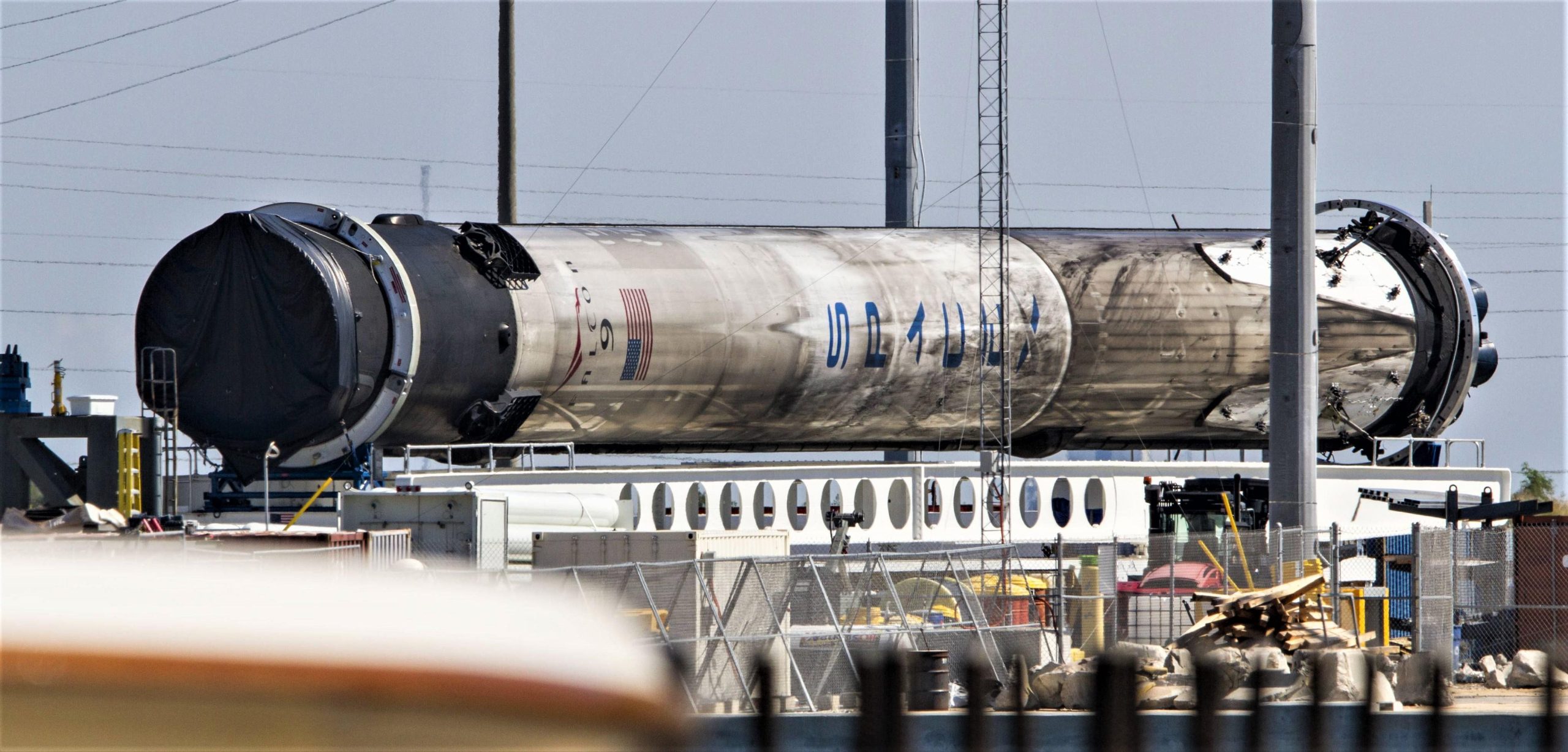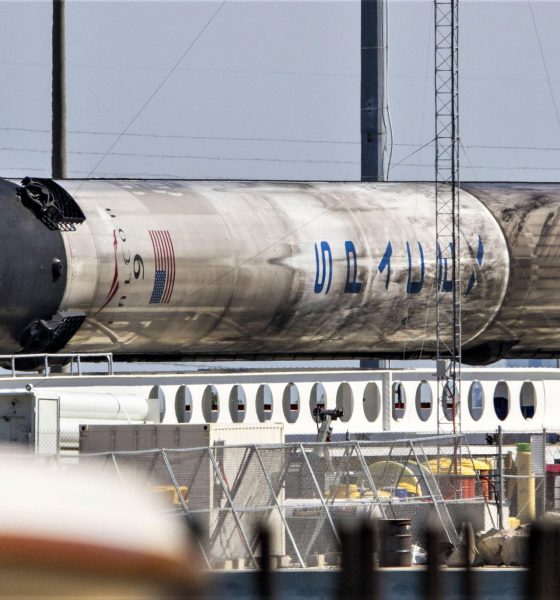

News
SpaceX’s Falcon 9 Block 5 boosters landing in great shape as competitors betray anxiety
SpaceX President and Chief Operating Officer Gwynne Shotwell has announced that the company’s upgraded Falcon 9 Block 5 rocket – debuted in May 2018 – is making its way through peak-stress launches, reentries, and landings in “much better shape than anticipated”, ultimately meaning that Falcon 9 booster refurbishment can now take as little as four weeks between flights.
At the same time, Shotwell’s industry peers and competitors continue to betray some level of real anxiety about SpaceX’s meteoric rise and technological step up with displays of hyperbolic overconfidence.
Shotwell: Falcon 9 first stages come back in much better shape than anticipated. Have refurbishment time down to four weeks; goal is still a one-day turnaround next year. #WSBW
— Jeff Foust (@jeff_foust) September 11, 2018
Speaking on a panel of launch providers at 2018’s Paris-based World Satellite Business Week conference, the discussion was rich with banter and comparatively heated comments from leaders of companies like Arianespace, ILS (International Launch Services, a commercial arm of Roscosmos), ULA, and Blue Origin, as well as SpaceX’s own Gwynne Shotwell. As effortlessly confident as ever, Shotwell’s presence and, perhaps, the general state of the industry appeared to trigger some rather brash and thoroughly entertaining fireworks from other executives.
United Launch Alliance’s Tory Bruno, CEO of a company that has literally never recovered or reused any flown hardware from one of its launches, noted that ULA’s wholly-unproven and untested strategy for reuse – unlikely to begin flight tests before the mid-2020s – would likely be superior to SpaceX’s own approach, apparently owing to the fact that the company has yet to reuse their Falcon 9 boosters dozens of times. ULA has yet to so much as announce the rocket engines it will use on its next-generation expendable rocket, known as Vulcan, expected to conduct its first-ever launch no earlier than the second half of 2020. Their current Atlas 5, Delta II, and Delta IV launch vehicles are and will remain 100% expendable up to the end of their careers.
ULA’s Tory Bruno talks up component (engine) recovery the company is planning; notes that despite SpaceX technical successes with landing and reuse, haven’t yet demonstrated ability to reuse stages large number (10-20) times. #WSBW
— Jeff Foust (@jeff_foust) September 11, 2018
Nevertheless, ILS President Kirk Pysher didn’t let Bruno steal all of the allotted braggadocio, making the humorous claim that “our customers don’t care about reusability” so long as “their launch is on time, reliable, and at the right price point”. Indeed, if one could actually launch a fully expendable rocket at a price point competitive with an organically-priced reusable rocket (i.e. no artificial inflation to recoup $1 billion of investment in the tech, which SpaceX is choosing to do), Pysher’s statement would be 100% accurate. Instead, ILS can lay claim to no more than a tiny fraction of commercial launch contracts today, dramatically hobbled by the fact that development of the company’s only potential competitive advantage – Proton Medium – has been indefinitely frozen, likely killing the rocket.
https://twitter.com/FDF/status/1039532650355204102
All things considered, Shotwell remains a breath of fresh air in an increasingly stale group, stoic, factual, and straightforward in the face of cantankerous and withering titans of the rocket industry. Speaking last week to a Masters of Business Administration class in Madrid, Spain, Shotwell bluntly and rather accurately stated that “with the advent of SpaceX, I think everyone in the industry is happy except other launch providers.” Much like other similar sessions at conferences earlier this year and otherwise, today’s conference panel of launch provider executives certainly serves to drive home just how correct the SpaceX President is.
https://twitter.com/FDF/status/1039530577454686209
For prompt updates, on-the-ground perspectives, and unique glimpses of SpaceX’s rocket recovery fleet check out our brand new LaunchPad and LandingZone newsletters!

News
Tesla FSD fleet is nearing 7 billion total miles, including 2.5 billion city miles
As can be seen on Tesla’s official FSD webpage, vehicles equipped with the system have now navigated over 6.99 billion miles.

Tesla’s Full Self-Driving (Supervised) fleet is closing in on almost 7 billion total miles driven, as per data posted by the company on its official FSD webpage.
These figures hint at the massive scale of data fueling Tesla’s rapid FSD improvements, which have been quite notable as of late.
FSD mileage milestones
As can be seen on Tesla’s official FSD webpage, vehicles equipped with the system have now navigated over 6.99 billion miles. Tesla owner and avid FSD tester Whole Mars Catalog also shared a screenshot indicating that from the nearly 7 billion miles traveled by the FSD fleet, more than 2.5 billion miles were driven inside cities.
City miles are particularly valuable for complex urban scenarios like unprotected turns, pedestrian interactions, and traffic lights. This is also the difference-maker for FSD, as only complex solutions, such as Waymo’s self-driving taxis, operate similarly on inner-city streets. And even then, incidents such as the San Francisco blackouts have proven challenging for sensor-rich vehicles like Waymos.
Tesla’s data edge
Tesla has a number of advantages in the autonomous vehicle sector, one of which is the size of its fleet and the number of vehicles training FSD on real-world roads. Tesla’s nearly 7 billion FSD miles then allow the company to roll out updates that make its vehicles behave like they are being driven by experienced drivers, even if they are operating on their own.
So notable are Tesla’s improvements to FSD that NVIDIA Director of Robotics Jim Fan, after experiencing FSD v14, noted that the system is the first AI that passes what he described as a “Physical Turing Test.”
“Despite knowing exactly how robot learning works, I still find it magical watching the steering wheel turn by itself. First it feels surreal, next it becomes routine. Then, like the smartphone, taking it away actively hurts. This is how humanity gets rewired and glued to god-like technologies,” Fan wrote in a post on X.
News
Tesla starts showing how FSD will change lives in Europe
Local officials tested the system on narrow country roads and were impressed by FSD’s smooth, human-like driving, with some calling the service a game-changer for everyday life in areas that are far from urban centers.

Tesla has launched Europe’s first public shuttle service using Full Self-Driving (Supervised) in the rural Eifelkreis Bitburg-Prüm region of Germany, demonstrating how the technology can restore independence and mobility for people who struggle with limited transport options.
Local officials tested the system on narrow country roads and were impressed by FSD’s smooth, human-like driving, with some calling the service a game-changer for everyday life in areas that are far from urban centers.
Officials see real impact on rural residents
Arzfeld Mayor Johannes Kuhl and District Administrator Andreas Kruppert personally tested the Tesla shuttle service. This allowed them to see just how well FSD navigated winding lanes and rural roads confidently. Kruppert said, “Autonomous driving sounds like science fiction to many, but we simply see here that it works totally well in rural regions too.” Kuhl, for his part, also noted that FSD “feels like a very experienced driver.”
The pilot complements the area’s “Citizen Bus” program, which provides on-demand rides for elderly residents who can no longer drive themselves. Tesla Europe shared a video of a demonstration of the service, highlighting how FSD gives people their freedom back, even in places where public transport is not as prevalent.
What the Ministry for Economic Affairs and Transport says
Rhineland-Palatinate’s Minister Daniela Schmitt supported the project, praising the collaboration that made this “first of its kind in Europe” possible. As per the ministry, the rural rollout for the service shows FSD’s potential beyond major cities, and it delivers tangible benefits like grocery runs, doctor visits, and social connections for isolated residents.
“Reliable and flexible mobility is especially vital in rural areas. With the launch of a shuttle service using self-driving vehicles (FSD supervised) by Tesla in the Eifelkreis Bitburg-Prüm, an innovative pilot project is now getting underway that complements local community bus services. It is the first project of its kind in Europe.
“The result is a real gain for rural mobility: greater accessibility, more flexibility and tangible benefits for everyday life. A strong signal for innovation, cooperation and future-oriented mobility beyond urban centers,” the ministry wrote in a LinkedIn post.
News
Tesla China quietly posts Robotaxi-related job listing
Tesla China is currently seeking a Low Voltage Electrical Engineer to work on circuit board design for the company’s autonomous vehicles.

Tesla has posted a new job listing in Shanghai explicitly tied to its Robotaxi program, fueling speculation that the company is preparing to launch its dedicated autonomous ride-hailing service in China.
As noted in the listing, Tesla China is currently seeking a Low Voltage Electrical Engineer to work on circuit board design for the company’s autonomous vehicles.
Robotaxi-specific role
The listing, which was shared on social media platform X by industry watcher @tslaming, suggested that Tesla China is looking to fill the role urgently. The job listing itself specifically mentions that the person hired for the role will be working on the Low Voltage Hardware team, which would design the circuit boards that would serve as the nervous system of the Robotaxi.
Key tasks for the role, as indicated in the job listing, include collaboration with PCB layout, firmware, mechanical, program management, and validation teams, among other responsibilities. The role is based in Shanghai.
China Robotaxi launch
China represents a massive potential market for robotaxis, with its dense urban centers and supportive policies in select cities. Tesla has limited permission to roll out FSD in the country, though despite this, its vehicles have been hailed as among the best in the market when it comes to autonomous features. So far, at least, it appears that China supports Tesla’s FSD and Robotaxi rollout.
This was hinted at in November, when Tesla brought the Cybercab to the 8th China International Import Expo (CIIE) in Shanghai, marking the first time that the autonomous two-seater was brought to the Asia-Pacific region. The vehicle, despite not having a release date in China, received a significant amount of interest among the event’s attendees.








